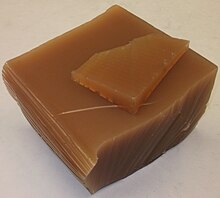Fluororubber
The term fluororubber ( abbreviation FKM according to DIN ISO 1629 [formerly: FPM ] and according to ASTM D 1418) describes a whole group of rubbers which have vinylidene (di) fluoride (VDF) as one of their monomers as one of their common characteristics. Fluororubbers were developed by DuPont ( Viton ) in the 1950s and are now also offered by Solvay ( Tecnoflon ), Dyneon ( Dyneon ™ Fluoroelastomers ) and Daikin Chemical ( Dai-El ).
In addition to fluororubbers, there are other groups of fluorinated elastomers, such as. B. perfluorinated rubber (FFKM), tetrafluoroethylene / propylene rubbers (FEPM) and fluorinated silicone rubber (FVMQ).
The two main types of fluororubbers are
- Copolymers of vinylidene fluoride (VDF) and hexafluoropropylene (HFP) and
- Terpolymers of VDF, HFP and tetrafluoroethylene (TFE)
Due to the additionally introduced TFE, the terpolymers have a higher fluorine content than the copolymers (approx. 68-69% compared to 66% for the copolymers), which is reflected in the better resistance to chemicals and higher temperatures. Copolymers, on the other hand, have advantages in terms of compression set and low temperature flexibility .
Besides that there is also
- Polymers made from VDF, HFP, TFE and perfluoromethyl vinyl ether (PMVE)
- Polymers made from VDF, TFE and propene , as well as
- Polymers made from VDF, HFP, TFE, PMVE and ethene
Perfluoromethyl vinyl ether (PMVE) is used in the rubbers to improve the low-temperature flexibility. The polymers with propene are more resistant to alkalis than other types of FPM, but they swell much more strongly in hydrocarbons . Polymers with ethene still show resistance to hydrogen sulfide even at high temperatures .
Networking mechanisms
Fluororubbers cannot be used as e.g. B. natural rubber can be crosslinked with sulfur , since the polymer chains are saturated (ie they lack the double bonds required for sulfur vulcanization ). Other mechanisms have therefore been developed to link the fluoropolymers to form elastic networks.
The oldest method of vulcanizing fluororubbers is diamine crosslinking . Blocked diamines are used as crosslinkers. In a basic environment the vinylidene fluoride may be hydrogen fluoride (HF) split off, whereby an addition of the amine is allowed to the polymer chain. The resulting hydrofluoric acid (HF) is usually captured by magnesium oxide , which is then converted into magnesium fluoride . The diamine crosslinking is still popular today because of the good adhesion between rubber and metal that is achieved with diamine crosslinked elastomers . In aqueous media, however, the diamine linkage is susceptible to hydrogenation.
In contrast, the bisphenolic mechanism (also known as the dihydroxy mechanism), in which bisphenol AF and a quaternary phosphonium salt are used as crosslinking components, is more modern than the diamine process . This is a nucleophilic substitution mechanism . Compared to diamine crosslinking, better resistance to hydrolysis and higher temperatures as well as an improvement in compression set are achieved.
In addition, fluororubbers can also be crosslinked peroxidically (also known as the triazine process), i.e. by free radicals . Peroxidic crosslinking is particularly important when rubbers containing perfluoromethyl vinyl ether (PMVE) are used, since the two ionic mechanisms can destroy the polymer chains by attacking the PMVE. In aqueous and non-aqueous electrolytes, peroxidically crosslinked fluoroelastomers are superior to the products of other crosslinking mechanisms. In terms of temperature resistance, they rank just behind bisphenolically crosslinked materials.
Web links
- Constructing with fluoroelastomers (German) (PDF file; 770 kB)
- Fluorine-Containing Elastomers (English) (PDF file; 74 kB)


